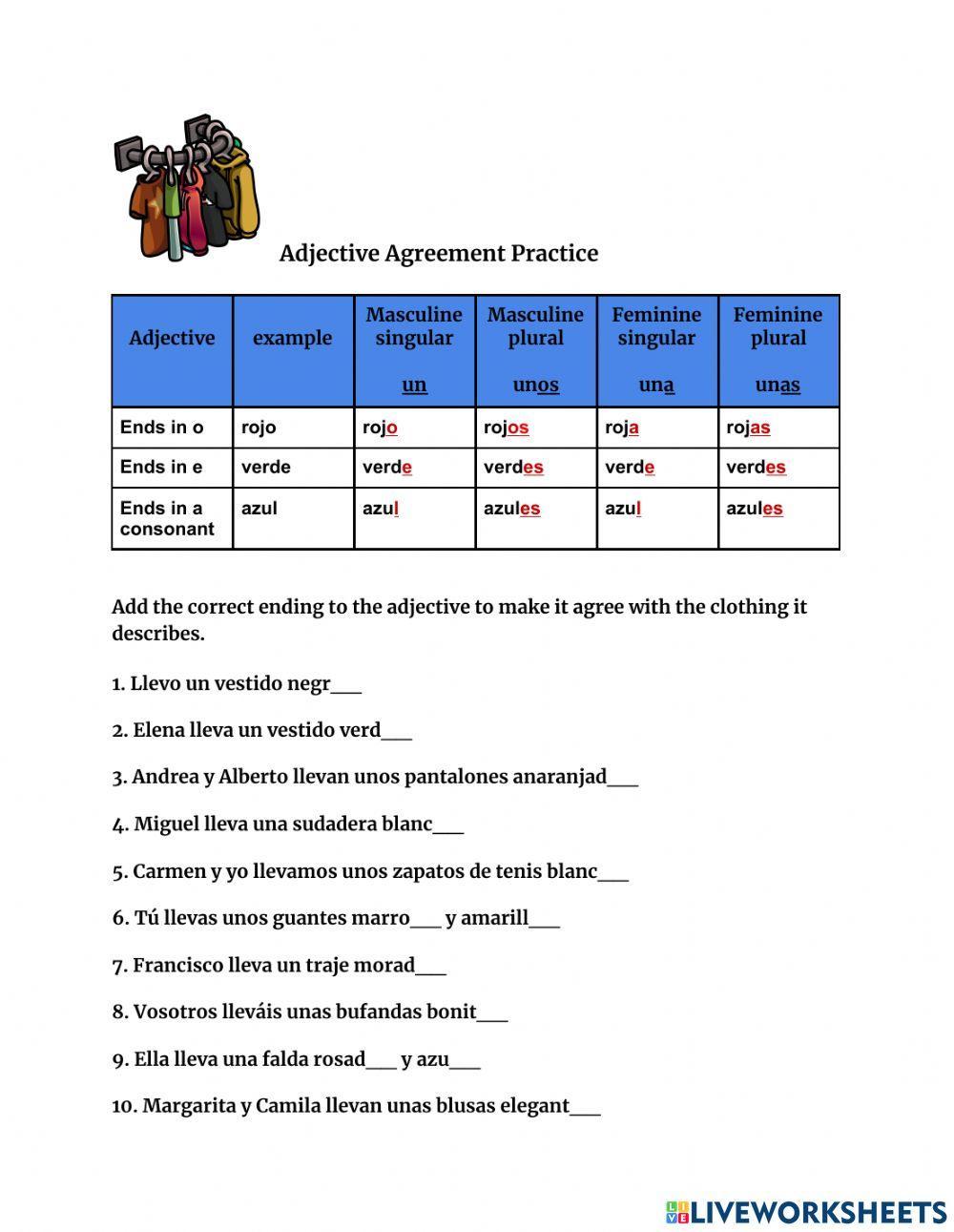
Mastering Adjective Agreement: The Indispensable Role of the Adjective Agreement Worksheet
In the intricate tapestry of language, adjectives serve as vibrant threads, adding color, detail, and specificity to our nouns. They allow us to distinguish between a "big house" and a "small house," a "happy child" and a "sad child," or a "fast car" and a "slow car." However, the journey to grammatical fluency often encounters a significant hurdle: adjective agreement. While English is relatively lenient with its descriptive adjectives, many other languages, and even certain aspects of English itself, demand that adjectives "agree" with the nouns they modify in terms of gender, number, or case. This crucial grammatical concept can be challenging for learners, making the adjective agreement worksheet an indispensable tool in their linguistic arsenal.
The Nuances of Adjective Agreement: A Foundation for Understanding
At its core, adjective agreement refers to the grammatical rule that requires an adjective to match, or "agree with," the noun or pronoun it modifies in specific grammatical categories. These categories typically include:

- Gender: In many languages (e.g., Spanish, French, German, Italian), nouns are assigned a gender (masculine, feminine, or sometimes neuter). Adjectives modifying these nouns must change their form to match that gender. For instance, in Spanish, you would say "el libro rojo" (the red book, masculine) but "la casa roja" (the red house, feminine).
- Number: This is perhaps the most universally understood aspect of agreement. If a noun is singular, the adjective takes a singular form; if the noun is plural, the adjective takes a plural form. In French, "une grande voiture" (a big car, singular) becomes "des grandes voitures" (big cars, plural). Even in English, while descriptive adjectives generally don’t change, demonstrative adjectives do: "this book" (singular) vs. "these books" (plural).
- Case: Less common for adjectives in modern languages, but prevalent in classical languages like Latin and German, case agreement dictates that an adjective changes its ending to reflect the grammatical function (e.g., subject, object, possessive) of the noun it modifies.

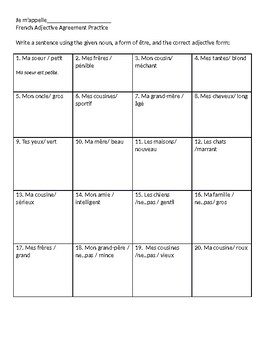
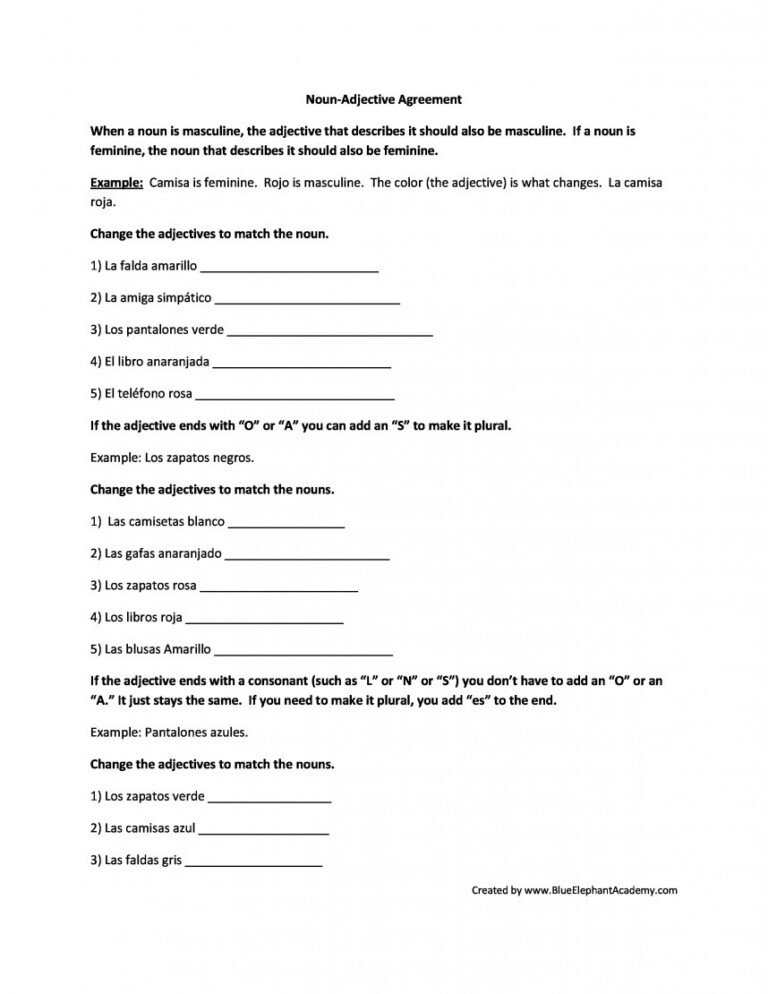
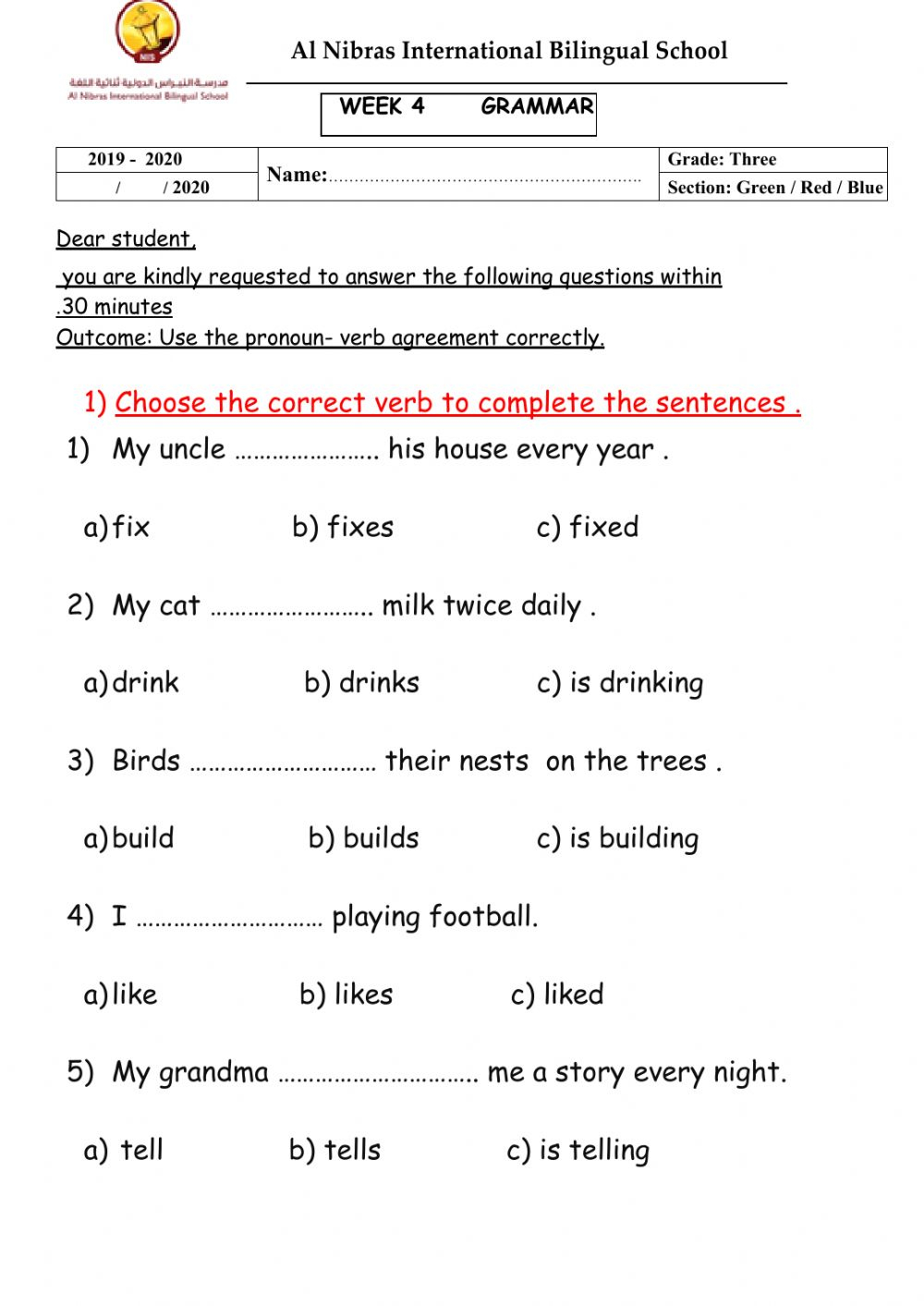
For English speakers learning a language with robust adjective agreement rules, this concept often presents a steep learning curve. The absence of widespread inflectional agreement for descriptive adjectives in their native tongue means they lack an intuitive grasp of the concept. Conversely, for non-native English speakers, understanding the subtle instances of agreement in English (like demonstratives or even the implicit agreement of predicate adjectives) can also be tricky. This is precisely where a structured and targeted approach, often facilitated by an adjective agreement worksheet, becomes invaluable.
Why the Adjective Agreement Worksheet is a Cornerstone of Learning
Learning a new grammatical rule involves more than just memorizing it. It requires active application, repetition, and the ability to identify and correct errors. The adjective agreement worksheet excels in providing this comprehensive learning experience for several key reasons:
- Structured Practice: Worksheets break down complex rules into manageable exercises. Instead of being overwhelmed by all the agreement rules at once, learners can focus on one aspect (e.g., gender agreement with regular adjectives) before moving on.
- Active Engagement: Unlike passive reading or listening, completing a worksheet demands active participation. Learners must recall the rules, apply them, and write down their answers, cementing the information in their minds.
- Identification of Weak Spots: As learners work through exercises, they inevitably make mistakes. These errors are not failures but valuable indicators of specific areas where their understanding is weak. A well-designed worksheet, especially with an answer key, allows for immediate self-assessment and targeted review.
- Repetition and Reinforcement: Mastery in language comes from consistent practice. Worksheets provide ample opportunities for repetition, ensuring that the rules of agreement become second nature rather than something that needs to be consciously recalled every time.
- Variety of Exercise Types: To prevent monotony and cater to different learning styles, effective worksheets incorporate diverse exercise formats, from simple matching to complex sentence construction, keeping the learner engaged.
- Measurable Progress: Completing a worksheet offers a tangible sense of accomplishment and allows both learners and educators to track progress over time.

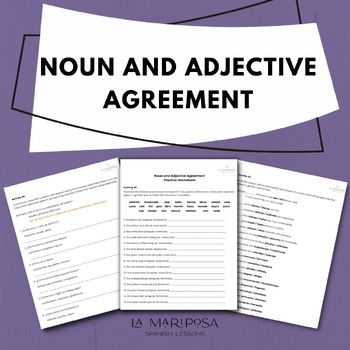
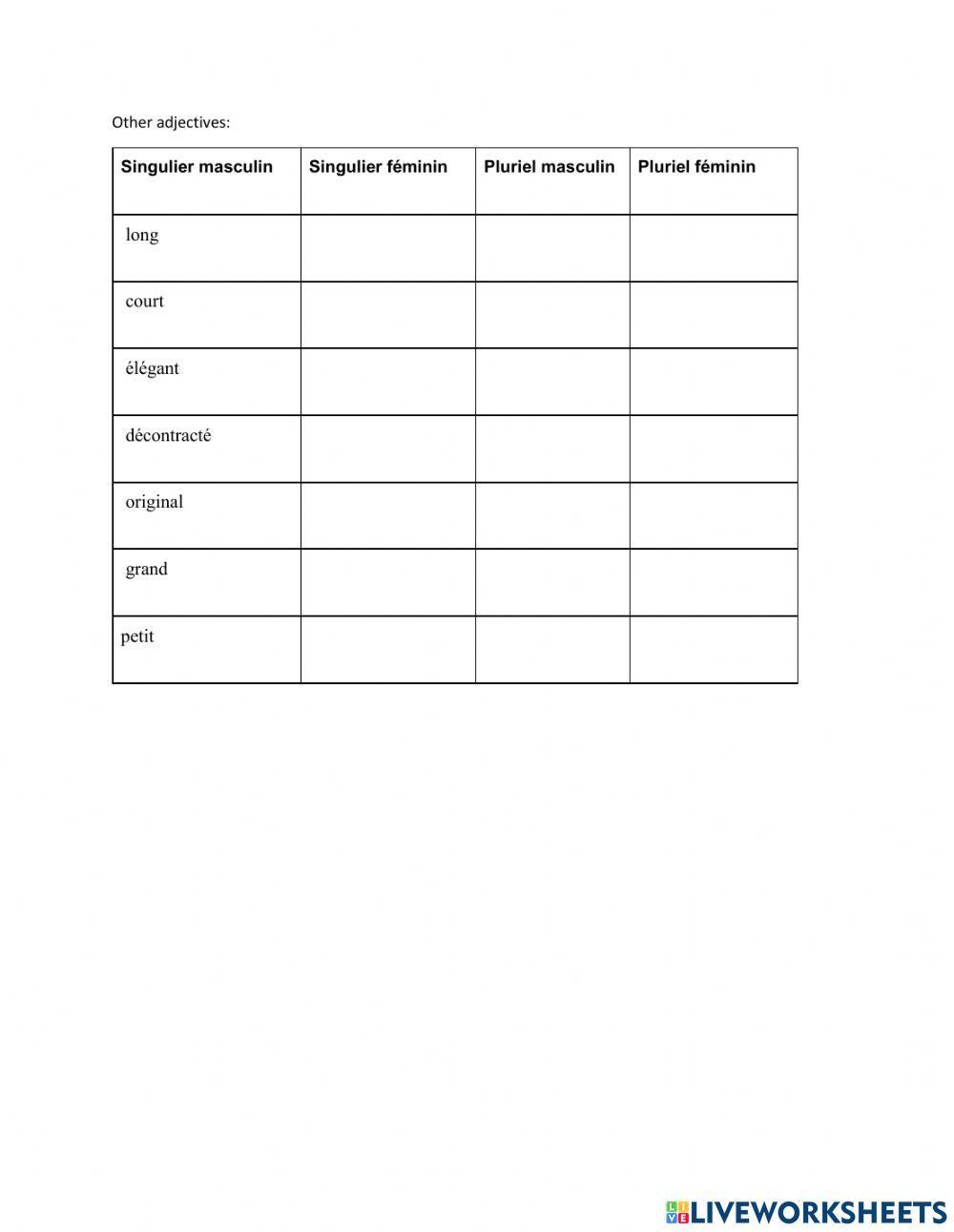

Components of an Effective Adjective Agreement Worksheet
A truly effective adjective agreement worksheet is more than just a list of sentences. It’s a carefully crafted pedagogical tool designed to guide learners from understanding to mastery. Here are the essential components:
- Clear Instructions and Rule Review: Each section of the worksheet should begin with concise instructions and, ideally, a brief review of the specific agreement rules being practiced. This ensures learners know exactly what is expected and have the necessary information at their fingertips.
- Identification Exercises: These exercises help learners recognize adjectives and the nouns they modify. Examples include:
- Underlining adjectives and circling the nouns they describe.
- Identifying the gender and number of given nouns.
- Matching Exercises: Simple yet effective, these exercises present a list of nouns and a list of adjectives (perhaps in their base form). Learners must draw lines connecting each noun to the correctly agreed-upon form of an adjective.
- Fill-in-the-Blank Exercises: This is a staple of grammar worksheets. Learners are given sentences with blanks and a base form of an adjective (e.g., "The ____ (red) car is fast."). They must then provide the correct, agreed-upon form of the adjective in the blank. This format directly tests their knowledge of agreement rules.
- Sentence Completion/Construction: More advanced exercises might require learners to complete sentences using their own adjectives, ensuring agreement, or even to construct original sentences using specific nouns and adjectives, putting their creative and grammatical skills to the test simultaneously.
- Error Correction: A highly valuable exercise type, error correction presents sentences containing adjective agreement mistakes. Learners must identify and correct these errors. This not only reinforces correct usage but also develops critical thinking and an eye for detail.
- Translation Exercises (for language learners): For those learning a foreign language, translating sentences from their native tongue into the target language, paying careful attention to adjective agreement, is an excellent way to bridge the gap between theoretical knowledge and practical application.
- Challenge/Advanced Sections: To cater to different proficiency levels, an excellent worksheet might include sections with irregular adjectives, exceptions to rules, or more complex sentence structures.
- Comprehensive Answer Key: Crucial for self-study and immediate feedback, a detailed answer key allows learners to check their work, understand where they went wrong, and reinforce correct answers.
Designing and Utilizing Your Adjective Agreement Worksheet
Whether you are an educator creating materials or a self-learner seeking to improve, optimizing the design and use of an adjective agreement worksheet can significantly enhance the learning experience.
For Educators:
- Scaffold Learning: Start with simpler concepts (e.g., regular singular/plural agreement) and gradually introduce more complex rules (e.g., irregular adjectives, gender agreement with multiple adjectives).
- Vary Contexts: Use a variety of sentence topics and vocabulary to keep the exercises engaging and relevant.
- Integrate with Lessons: Worksheets should complement classroom instruction, reinforcing what has been taught.
- Provide Constructive Feedback: Beyond just marking right or wrong, explain why an answer is incorrect and offer guidance for improvement.
- Encourage Peer Review: Having students review each other’s work can foster collaborative learning and deeper understanding.
For Learners:
- Understand, Don’t Just Memorize: Before attempting the worksheet, ensure you understand the underlying agreement rules. Don’t just blindly fill in answers.
- Use the Answer Key Wisely: Don’t peek! Complete the worksheet first, then use the answer key to check your work. Analyze your mistakes to understand the rule you missed.
- Regular Practice: Consistency is key. Dedicate regular, short periods to practice rather than cramming.
- Combine with Real-World Language: Try to notice adjective agreement in books, movies, or conversations in the target language. Actively try to apply the rules in your own speaking and writing.
- Don’t Be Afraid to Make Mistakes: Errors are part of the learning process. Embrace them as opportunities to learn and grow.
Beyond the Worksheet: Reinforcing Agreement in Practice
While the adjective agreement worksheet provides a structured and focused environment for practice, true mastery comes from integrating this knowledge into all aspects of language use.
- Extensive Reading: As you read in the target language, consciously observe how adjectives change to agree with their nouns. Pay attention to patterns.
- Active Listening: In spoken language, notice the subtle phonetic changes or word endings that indicate adjective agreement.
- Conscious Speaking and Writing: When producing language, make a deliberate effort to apply the agreement rules. Start by focusing on accuracy, even if it slows you down initially. Speed will come with practice.
- Flashcards and Digital Tools: Create flashcards with nouns and their corresponding adjective forms. Utilize language learning apps and online quizzes that often incorporate agreement exercises.
- Language Exchange Partners: Practice with native speakers and ask them to gently correct your agreement errors.
Conclusion
Adjective agreement, while sometimes challenging, is a fundamental aspect of grammatical correctness and clarity in many languages. It ensures that our descriptions are precise and our sentences flow naturally. The adjective agreement worksheet, in its various forms and components, stands out as an exceptionally effective tool for navigating this grammatical terrain. By providing structured practice, facilitating active learning, and pinpointing areas for improvement, it empowers learners to transform complex rules into intuitive habits. From the foundational concept to fluent communication, the humble adjective agreement worksheet plays an indispensable role in building the confidence and competence required to master the beautiful and nuanced art of language.
